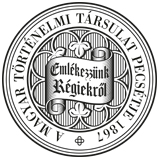Századok – 2003
TANULMÁNYOK - Tóth Endre: Hoholt - Hahót. A jövevény nemzetségek eredetéhez 265
296 TÓTH ENDRE 190.) The genealogy of the counts of Orlamünde is known. The Hungarian family can not be inserted into it, and the name Hohold never turns up among the comital kin. Simon Kézai, if the localities named by him are actually Meissen and Wartburg, makes the family descend from Thuringia. Yet the name Hohold cannot be found there either. In the Hungarian charters from the end of the 12t h century the kindred is generally referred to as generatio de Buzad, from the Hungarian name Búzád used by them. One of the branches of the kindred used the name Hoholth through several generations. The name became a toponym as well, developing through a regular linguistic process from Hohold into the presently existing Hahót (Zala county). The family monestery of the kindred, dedicated to Saint Margaret, was erected at Hahót. The names used by the kindred were mostly Christian names common throughout Hungary (Nicholas, John, Michael), with some Hungarian (Atyusz, Csák, Panyit) names. Two German names, Hoholth and Arnold, were used for three or four and four generations respectively. Herbord and Feldrik (Friedrich) also occur once in the kindred. Literary names, more exactly those belonging to the Arthus-circle, also turn up very early in the kindred, significantly in the names of three brothers, Tristian, Lanceret and Yven, in the 1230s. The origins of the kindred can be reconstructed with the help of the name Hohold, which was not used in other Hungarian families. The name is not common in the Empire either; it belongs to those disyllabic names which are used in a relatively small area within a clearly identifiable group of families. It turns up first in the traditiones of Freising in the 8th century. The father of Arn, archbishop of Salzburg was called Hoholt. Later on it is used by the Isen-Tegernbach group, still around Freising, where it remains in use until the 13th century together with the name Arnold. In the 9t h century a Hoholt is referred to as a witness around Pitten as well as in the region of the rivel Zala and Mosaburg (Zalavár) in present-day Hungary. Other Hoholts occur in Carinthia in the 9th and 10t h centuries. The Hungarian Hoholts cannot be inserted into the fragmented genealogies of Bavarian families, but, on the basis of the name, very uncommon, their belonging to the Isen-Tegernbach group can be taken as extremely probable. The sub-region whence the kindred migrated to Hungary cannot be determined with certainty, however. The Hoholt who turns up in 869 and 876-880 in the region of the river Zala is conspicuous, for the site of the affair mentioned in the traditio borders from the north the possessions of the kindred in the 13th and 14t h centuries. It is utterly improbable that the original possessors could have survived there the Hungarian conquest. On the other hand, it is possible that from the end of the 10t h century, when the relations between Hungary and Germany became peaceful, the migration of families of Bavarian and Alemannian origin into Hungary was influenced by their presence here already in the 9t h century. It seems almost certain in the case of the Buzád-Hahót kindred, where the immigrants of the late 10th century seem to have belonged to the same clan which had possessed lands in western Pannónia in the 9th century.
